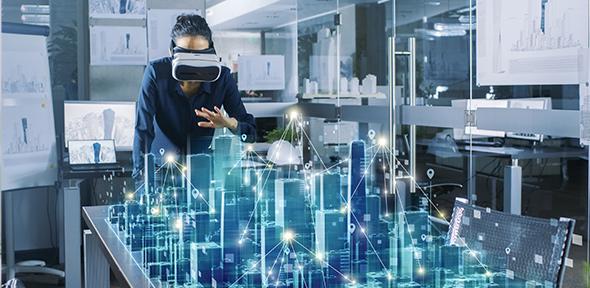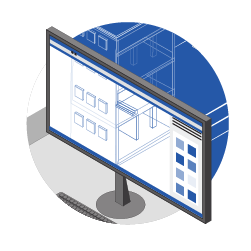
Submitted by Angela Walters on Wed, 29/07/2020 - 12:01
As the AEC industry takes steps to rebuild business as the country resets post-Covid-19 lockdown, Dr Manuel Davila Delgado, Associate Professor, Big Data Enterprise and Artificial Intelligence Laboratory at the University of the West of England, and lead for CDBB’s Vision Network, makes the case for driving industry adoption of augmented and virtual reality technologies to boost sector efficiency and productivity.
Potential benefits of applying smart construction solutions to increase productivity and efficiency in the sector are widely acknowledged by both industry and policy. The UK Government’s Construction 2025 strategy sets out the need for construction to position itself at the forefront of smart construction and digital design. Digital technologies and tools make an essential contribution to the sector’s arsenal in post-Covid-19 recovery – as set out in the Construction Leadership Council’s ‘Roadmap to Recovery’. In addition, digitally-enabled cyber physical systems (CPS) will also be critical in addressing challenges resulting from the effects of global societal and environmental issues, including population increase, urbanisation and climate change.
Augmented reality (AR) and virtual reality (VR) are already changing the ways we interact with visual information: VR is a technology that enables the creation of entirely computer-generated environments to create the sensation of being completely immersed within a virtual environment; AR is a technology that enables the overlay of digital information onto the real environment – in real time and in the correct spatial position – to augment or enhance the real environment. Many industries are already deploying AR and VR solutions for education, training and productivity improvements, and some early adopters in manufacturing report business being maintained throughout lockdown despite the majority of staff working from home.[1] Could AR and VR offer construction a key tool to operate efficiently, safely and productively if lockdown conditions affect the built environment long-term?
Benefits of AR and VR when applied to the built environment lifecycle sectors are numerous offering the ability to collaborate, communicate and review projects more efficiently – effectively rehearsing key aspects remotely to optimise outputs of design, construction and operation – while working at a distance during recovery from Covid-19, including:
- improving stakeholder engagement by giving consumers an opportunity to better examine built assets at real scale in an immersive environment – providing a deeper understanding of the assets than by looking at pictures or even videos
- consulting with clients and collaborating while working at a distance – overcoming challenges resulting from possible ongoing physical distancing measures during potential episodic national and regional lockdown. Firms will be able to consult and co-design in shared virtual editing environments to enable design work to progress remotely and maintain productivity. Designers will be able to experience a range of designs in realistic scenarios to better identify qualitative factors such as spaciousness, lighting and aesthetics
- communicating design intent and reviewing designs to efficiently identify issues and sign-off remotely (BIM models can be exported to VR environments) without the need for face-to-face meetings
- planning construction processes based on required materials updated in real-time responding to changes made by the user. Also remotely monitoring progress, detecting delays and hazards so fewer staff are required on site thus gaining the same benefits of visiting a site while maintaining a safe distance
- supporting both field and remote workers to collaborate in operations and management – providing useful information to site workers who operate and maintain the facilities. VR can provide a way to operate the facility remotely in an immersive environment
- improving training efficiency by simulating the use of expensive equipment, and dangerous environments, while reducing travel costs and improving health and safety.
Despite the potential sector-wide improvements offered, the level of adoption by AEC companies remains low. Recent research completed as part of CDBB’s Vision Network that explores the potential of AR and VR to contribute to the development of digital built Britain[2] identifies a number of factors currently limiting use of these technologies: AR and VR are still perceived as immature technologies not yet ready for commercial use; construction firms lack access to expertise and skills required to make best use of these technologies; and the equipment required to optimise benefits of AR and VR require sizeable financial investment. Despite these concerns, research showed many AEC firms acknowledge investment in these technologies will happen in the next three years.
Overcoming these challenges is possible and pressing and should be addressed as part of an organisation’s digital strategy. R&D efforts must now focus on developing technologies specific to the requirements of the AEC sectors[3]. Given the large investments required to implement AR and VR in terms of equipment, space, time and upskilling, only by developing AR and VR hardware and software specific to the AEC sectors can the investments be justified.
As industry makes plans to adapt to the ‘new normal’, VR and AR can support construction to connect, collaborate, make decisions and operate effectively remotely, reducing the number of site visits needed, detecting proximity to other workers and training staff remotely during downtime. With targeted research, moderate investment and technical development these technologies could be made ready for full commercial application and support the built environment sectors in their recovery to work more efficiently, productively and sustainably.
More information
“Augmented and Virtual Reality in Construction: Drivers and Limitations for Industry Adoption” by Delgado, Oyedele, Beach and Demian (2020) provides a systematic study presenting a detailed analysis of the factors that limit and drive adoption of AR and VR in the construction industry. The study groups and characterises myriad limiting and driving factors into easily understandable categories, so that the limiting factors can be effectively mitigated, and the driving factors potentiated. The research also features a roadmap with specific short-term and medium-term actions for improving adoption for AR and VR.
“A research agenda for augmented and virtual reality in architecture, engineering and construction” by Delgado, Oyedele, Demian and Beach (2020). This study presents the current usage landscape of AR and VR in the construction industry. It outlines the use-cases in which AR and VR can be used in the AEC sectors and a set of research topics necessary to meet the requirements for a successful AR and VR implementation. This study can inform practitioners on the best way to prepare for adoption or extend and maximise their implementation efforts.
[1] https://www.techradar.com/news/how-connected-industries-could-have-benefited-the-world-from-covid-19
[2] “Augmented and Virtual Reality in Construction: Drivers and Limitations for Industry Adoption” by Delgado, Oyedele, Beach and Demian (2020)
[3] “A research agenda for augmented and virtual reality in architecture, engineering and construction” by Delgado, Oyedele, Demian and Beach (2020)

